History of the Bo'ness Fair Day
To Bo’nessians, Bo’ness without its Fair would today seem inconceivable as Bo’ness without the River Forth or Bo’ness without its braes, yet at one time no self respecting person would have anything to do with the annual event, which is now the largest and most spectacular of its kind in the country. Unlike most of Scotland’s summer celebrations in towns throughout the Borders and Lowlands, which can trace origins to the traditional riding of the marches ceremonies or to old cattle fairs, Bo’ness Fair began, as one witness of the time described it, “as a drunken orgy” among the coal miners of the district.
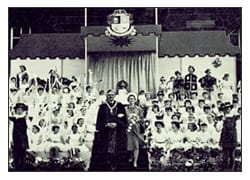 Until the latter part of the 18th century, it was customary for all Scottish miners to be thirled, that is, bound to the pits, as were any children who were born to them while they worked in them. Thus the bondage was continued from generation to generation and if any of the miners tried to escape from virtual slavery the colliery masters had the power to send their overseers to drag them back and to punish them severely. Even when a colliery owner sold his pit, the miners were included as part of the transaction. At last, 1774, a law was passed forbidding the thirling of miners and their families to the coal pits, but those already tied to the mines were not granted their freedom straightaway and it was not until 1779 that an Act declared that, “all the colliers in that part of Great Britain called Scotland, are hereby declared to be free from their seritude.”
Until the latter part of the 18th century, it was customary for all Scottish miners to be thirled, that is, bound to the pits, as were any children who were born to them while they worked in them. Thus the bondage was continued from generation to generation and if any of the miners tried to escape from virtual slavery the colliery masters had the power to send their overseers to drag them back and to punish them severely. Even when a colliery owner sold his pit, the miners were included as part of the transaction. At last, 1774, a law was passed forbidding the thirling of miners and their families to the coal pits, but those already tied to the mines were not granted their freedom straightaway and it was not until 1779 that an Act declared that, “all the colliers in that part of Great Britain called Scotland, are hereby declared to be free from their seritude.”
It was to celebrate this new-found liberty that the miners of Bo’ness who formed a very closeknit community of their own, staged their first Fair. From then on the Fair was held every year on the Friday in July which fell between the 12th and 19th, a date already connected with one of the four feeing fairs for which Anne, Duchess of Hamilton gained Parliamentary permission shortly after she won her battle for burgh status for Bo’ness in 1668.
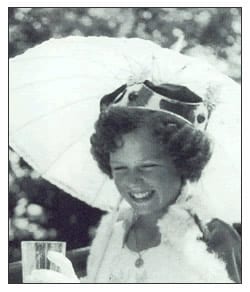 On this, their only holiday in the whole year, all pit workers from the long, low miners’ rows at Borrowstoun and Newtown, marched down into the narrow winding streets of Bo’ness and on out through Corbiehall to Kinneil House, home of the Duke of Hamilton, who owned many of the local pits. In front of the big house, on its hilltop overlooking the River Forth, the miners, led their elected deacon, wearing his ornate, bonnet, sash and sword, were received by the Duke ‘s estate factor, who provided them all with glasses of whisky toddy.
On this, their only holiday in the whole year, all pit workers from the long, low miners’ rows at Borrowstoun and Newtown, marched down into the narrow winding streets of Bo’ness and on out through Corbiehall to Kinneil House, home of the Duke of Hamilton, who owned many of the local pits. In front of the big house, on its hilltop overlooking the River Forth, the miners, led their elected deacon, wearing his ornate, bonnet, sash and sword, were received by the Duke ‘s estate factor, who provided them all with glasses of whisky toddy.
From Kinneil the march continued, with frequent halts for refreshments, to the old Grange, the home of the other big colliery owner in Bo’ness, Mr. James John Cadell. Mr Cadell, himself, always welcomed his men and on this one day in the year it is reported that the “Maister” relaxed his usually severe manner and even handed round the whisky toddy to his miners, an act which greatly delighted them. A brass band, imported during the early years from Falkirk, always accompanied the marchers and while they enjoyed their free drinks, it played on the lawn in front of the old Grange, before leading them down to the banks of the Forth, where horse races were held on the foreshore, throughout the afternoon.
The most distinguished visitor to the Bo’ness races was Robert Burns, but he was little impressed with the standard of the races as he was with the rest of Bo’ness, which he descrbed as, “that dirty ugly place, Borrowstounness”, and which certainly did not inspire him to verse. It is little wonder that Burns was not thrilled by the races, for the mounts were just local carriage and wagon horses, pressed into service for the day and generally most of them had already done duty earlier in the day, carrying the Deacon and other miners’ leaders at the head of the procession.
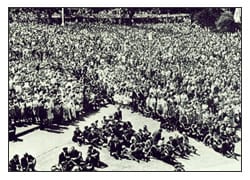 Once the last race was over the crowd returned to Corbiehall, where the booths and side stalls of the fairground were set up and the ginger bread sellers did a roaring trade. Later there was dancing in the Town Hall, where all miners and their wives and daughters could afford to join in the merrymaking, as they paid separately for each dance at one penny a time.
Once the last race was over the crowd returned to Corbiehall, where the booths and side stalls of the fairground were set up and the ginger bread sellers did a roaring trade. Later there was dancing in the Town Hall, where all miners and their wives and daughters could afford to join in the merrymaking, as they paid separately for each dance at one penny a time.
Drinking, was however, the main attraction of the Fair and the town’s many pubs and inns were crowded. In those days there were no licensing laws and the pubs stayed open throughout the night so that the festivities continued right into the following Saturday, or at least as long as the miners’ money lasted. The remainder of the weekend the miners spent sobering up, returning to the pits to start work again early on the Monday morning. Their annual holiday was over and there was only the next year to look forward to, to brighten their dreary existence, so they immediately appointed a new Deacon to act as their leader and make a start to the arrangements for the following year’s Fair.
Gradually, as the years of Queen Victoria’s long reign passed, and the barriers between the coal miners and the other members of the community were slowly broken down, other workers in the town began to take part in the Fair and each of the trades found in Bo’ness was represented in the procession. One of the most interesting and colourful groups in the procession was made up by the craftsmen from the local potteries, for the potters always wore their white trousers, white aprons tied with balck ribbons, black tail coats and tall black lum hats and carried with them examples of their craft and symbols of their trade, including model china sailing ships, and miniature kilns.
Although for a time more of the townspeople took part in the festivities, as Queen Victoria’s reign wore on the Fair’s popularity began to wane partly because of the excessive drinking which took place at it and which shocked the more soberly minded citizens.
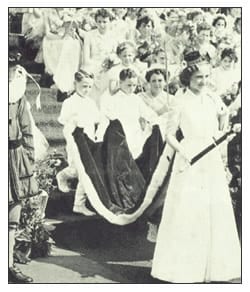 Finally, in 1894, the miners realised that something had to be done if their annual celebration was not to die out and so they approached the local Police Commissioners, who at this time governed Bo’ness, before the creation of a Town Council, and suggested that these gentlemen should take part in the Fair Procession. The very proposal caused consternation in the town and several of the Commissioners were opposed to associating themselves in any way with this day of drinking, one demanded to know whether they would be expected, “to get fou like the rest?” After long and heated discussions, however, Provost Ballantine persuaded his colleagues to join in the proceedings, on the strict understanding that they would be properly conducted.
Finally, in 1894, the miners realised that something had to be done if their annual celebration was not to die out and so they approached the local Police Commissioners, who at this time governed Bo’ness, before the creation of a Town Council, and suggested that these gentlemen should take part in the Fair Procession. The very proposal caused consternation in the town and several of the Commissioners were opposed to associating themselves in any way with this day of drinking, one demanded to know whether they would be expected, “to get fou like the rest?” After long and heated discussions, however, Provost Ballantine persuaded his colleagues to join in the proceedings, on the strict understanding that they would be properly conducted.
Announcing their decision, Provost Ballantine stated grandly that he felt that, “It became the authorities of any place that, for one day at least, they should be on a level with their neighbours”, and that, therefore it was, “quite in keeping that the Commissioners of Bo’ness and others outside should for a few hours, join in the general friendship and forget any differences that have taken place.”
And so that year the parade was led usual by the miners’ Deacon, but he was followed by the Provost and the Commissioners in open landaux, flanked by scarlet-coated outriders and led by banner bearers proudly carrying a large banner depicting the Burgh Coat of Arms with its ship under full sail and on a scroll beneath it the town’s motto, “Sine Metu” – “Without Fear”.
At last a touch of pageantry had been added to Bo’ness Fair, but this was nothing compared to what was to come only three years later in 1897, at the time of Queen Victoria’s Diamond Jubilee, for the wave of celebrations, which swept across the country was seized by Provost Stewart as the ideal opportunity to bring the children of the town into the festivities for the first time. As his model he chose Lanark’s Lanimer Day, at which the boys and girls of the town elected one of their school friends to be their Fair Queen. The new-style Bo’ness Fair was received with great enthusiasm by the local people and first school girl “Queen”, Grace Strachan, chosen by the pupils of the old Anderson Academy, was cheered as she rode in her carriage in the first grand procession after her coronation, which was performed in Craigallen Park by Mrs Balfour, wife of the Chairman of the school board.
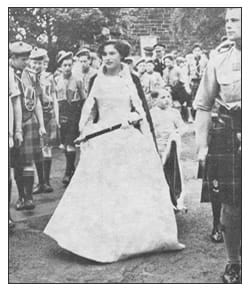 From Craigallen the procession made its way out to the Kinnigars Park at Carriden, where the first Queen’s revels were held. The route took it down to the new Philpingstone Road, which was officially declared open by Mrs Cadell, before the Queen’s horse-drawn carriage entered it from Grange Terrace.
From Craigallen the procession made its way out to the Kinnigars Park at Carriden, where the first Queen’s revels were held. The route took it down to the new Philpingstone Road, which was officially declared open by Mrs Cadell, before the Queen’s horse-drawn carriage entered it from Grange Terrace.
In all over 2,000 children from Bo’ness Infant School, Grangepans Infant School, Bo’ness Public School, Kinneil School, Borrowstoun School and Carriden School, as well as the Anderson Academy, took part in the first Fair. As well as Queen Grace, many of her classmates from the Old Academy and boys and girls from all the other schools played the parts of gaily dressed lords and ladies of the royal court and fairies, flower girls and other characters, just as their grandchildren and great grandchildren still do every summer.
At the new-style Fair the emphasis was now all on the children’s enjoyment and old horse races were replaced by a programme of revels, which included sports and selections of music played by both brass and pipe bands. These early revels, which were held alternately at Kinnigars and Kinneil, must have been very colourful affairs, for all the children, both boys and girls, wore scarlet, blue and yellow caps, according to their school colours and all the little girls were dressed in their new white Fair dresses, while the little boys were all turned out in white flannel shorts and white shirts.
For the children there was an added touch of excitement about the Fair because it always marked the start of the school holidays and that the long hot summer weeks of freedom lay ahead.
“The morn’s the Fair and I’ll be there, And I’ll hae up my curlie hair,”
chanted the little Bo’ness girls as they raced home from school on the Fair E’en to gaze yet again at the new white dresses and shoes, which they would wear for the first time the following morning.
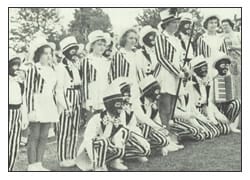 Since Provost Stewart launched his new children’s day the pageant has been staged every summer apart from the years during the First and Second World wars and the Industrial depressions in 1921 and 1926 until today it is the largest and most popular event of its kind in the country, until today it is undoubtedly the largest and simply the best children’s day in the entire length and breadth of the United Kingdom.
Since Provost Stewart launched his new children’s day the pageant has been staged every summer apart from the years during the First and Second World wars and the Industrial depressions in 1921 and 1926 until today it is the largest and most popular event of its kind in the country, until today it is undoubtedly the largest and simply the best children’s day in the entire length and breadth of the United Kingdom.
Nowadays the night before the Fair, locally simply called the Fair E’en, is the night when the population of the town is swelled considerably with the influx of many visitors from all over Central Scotland, thanks to the availability of modern transport. They come in their droves to join with the local inhabitants to view the fantastic creations constructed by the parents and friends of the children who will be participating in the Fair the next day. The ingenuity and inventiveness of our local townspeople have to be seen to be believed and some of these house frontages are almost beyond description. In bygone years, “going round the arches” meant just that, for our ancestors started it all. Then there were huge arches which in the main were built by the miners and they spanned the roads leading into the town at Kinneil, Newtown and Grangepans. In addition of course were dozens od smaller versions and these were to be found outside the homes of the children chosen to be characters at the Fair.
These huge arches were works of art – made generally with boxwood and nature’s evergreens – and great was the rivalry between the three areas competing for the First Prize Cards which were awarded by the judges. With Artisan art at its very best, and combined by the craft and expertise of our townspeople, many quite spectacular creations were produced, and it was with bated breath that the builders awaited the arrival of the judges on the Fair morning.
It wasn’t only the arch builders who were keen on being recognized as being the best in town, for horse drawn vans and subsequently motorized lorries were always beautifully decorated with greenery and flowers, both natural or made with crepe paper. The builders of these were also extremely competitive, and their products were always the highlight of the mile long procession. In the case of the horse drawn vehicles, the horses themselves were decorated to a wonderfully high standard, and were the sources of unbelievable and genuine admiration.
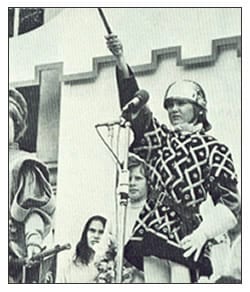 Today, apart from the Champion’s mount, horses have all but disappeared from the procession, but that old saying still remains – “she’s aw dressed up like a Fair horse”! And whilst many people rue the lack of decorated vehicles in the processions of latter years, it must be remembered that keeping a lorry off the road for any length of time is a very costly business. Those which do appear are to be commended, and are of an unusually high standard, and their builders are as enthusiastic and as artistic as their predecessors. Indeed, some of the tableaux, especially created for the Fair, have been entered later for the prestigious Edinburgh Festival Cavalcade and been recognized as the best in their class.
Today, apart from the Champion’s mount, horses have all but disappeared from the procession, but that old saying still remains – “she’s aw dressed up like a Fair horse”! And whilst many people rue the lack of decorated vehicles in the processions of latter years, it must be remembered that keeping a lorry off the road for any length of time is a very costly business. Those which do appear are to be commended, and are of an unusually high standard, and their builders are as enthusiastic and as artistic as their predecessors. Indeed, some of the tableaux, especially created for the Fair, have been entered later for the prestigious Edinburgh Festival Cavalcade and been recognized as the best in their class.
Naturally, with Bo’ness having at its disposal two Championship class Brass Bands in Unison Kinneil and Bo’ness and Carriden, Bo’ness Pipe Band, and the Salvation Army Band, music has always played a large part in the general festivities, from the early initial years until the present. In the very earliest of the Children’s Fairs the songs sung were, “Scots Wha Hae”, “Red White & Blue”, and “Auld Lang Syne”. The first of our present Fair songs was “Our Festal Day”, words by R. Fleming, music by E. C. Schofield, and it proved so popular that in a couple of years later in 1903, “Hail to our Queen”, words by Hope A. Thomson with music by L. Dyer Appleby, was added to the musical content. Over the years these songs have become very dear to the hearts of Bo’nessians, and have been sung whenever they meet, in the most unlikely places all over the world!
More recently, on the occasion of the Centenary Fair in 1997, a third song was added to the Bo’ness Children’s Fair Festival musical repertoire. “The Best Day of the Year”, words and music by J. Douglas Snedden and arranged for brass bands by Ian Boulter, reflects the demise of the varied industries that made Bo’ness almost self-contained as a Burgh, and the joy and enthusiasm that our Fair brings to the town every year. Sung at the coronation ceremony of Queen Ashley Oldham by a specially formed Centenary Choir, it is now played as the Queen and her retinue leave the stage after the coronation each year. The phrase “The best day of the year” is now generally recognized as being a direct reference to the Fair. It has also been used as the title by the makers of the film depicting the 100 years of Bo’ness Children’s Fair.
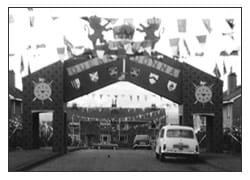 Tradition has been maintained in the coronation ceremony, which has changed very little over the years. But in 1968, which was the Tercentenary Year of the Burgh of Borrowstounness, certain changes were made to the continuity of the total coronation festivities in the Glebe Park. The stage was revamped and made larger by the introduction of a flat apron stage. Its purpose was to provide a stage for the presentations provided by the various schools. Up and until that time there had only been two children chosen as presentees, but from that year until the present upwards of sixteen children from each school perform a musical number for their newly crowned Majesty’s pleasure and entertainment.
Tradition has been maintained in the coronation ceremony, which has changed very little over the years. But in 1968, which was the Tercentenary Year of the Burgh of Borrowstounness, certain changes were made to the continuity of the total coronation festivities in the Glebe Park. The stage was revamped and made larger by the introduction of a flat apron stage. Its purpose was to provide a stage for the presentations provided by the various schools. Up and until that time there had only been two children chosen as presentees, but from that year until the present upwards of sixteen children from each school perform a musical number for their newly crowned Majesty’s pleasure and entertainment.
In that year also, several changes were made to the old style Royal Revels. The name became the Royal Command Performance, and over the years since then the afternoon show in the Douglas Park has seen every major theatrical and TV star in Scotland come to entertain the vast appreciative crowds on a medieval style double-tiered stage. International acts and bands, singers and dancers from Canada, Russia, America, Poland, Ukraine, France, Denmark and Norway have helped consolidate our Fair’s reputation as being the outstanding Children’s Day in the United Kingdom.
1966 also introduced the Kirkin of the Queen Ceremony, which is held on the Sunday immediately before the Fair, a service organised and conducted by the children and teachers of the particular school providing the retinue of that particular year.
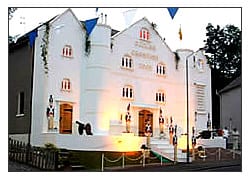 Up and until Regionalisation which took place in 1973/74, our Fair was, organised and run, in conjunction with schools, the Town Council. When that was swallowed up by Central Region and Falkirk Council, the responsibility of the existence and continuity of the Fair became that of the townspeople of Bo’ness. Bo’ness Children’s Fair Festival Executive Committee was formed and the running and organization of the Fair has been in their hands ever since. Each convenor of the various sub-committee has a specific job to do, and it is to their credit that the Fair has not only continued, but has gone from strength to strength.
Up and until Regionalisation which took place in 1973/74, our Fair was, organised and run, in conjunction with schools, the Town Council. When that was swallowed up by Central Region and Falkirk Council, the responsibility of the existence and continuity of the Fair became that of the townspeople of Bo’ness. Bo’ness Children’s Fair Festival Executive Committee was formed and the running and organization of the Fair has been in their hands ever since. Each convenor of the various sub-committee has a specific job to do, and it is to their credit that the Fair has not only continued, but has gone from strength to strength.
One such committee, the Entertainments Committee, was inadvertently responsible for a little piece of history in 1978. In the year previous to that, at that committee’e instigation, the Musical “South Pacific” was produced in the Town Hall by the enthusiastic, collection of talented musical friends in aid of Fair Funds. In the audience at the opening Gala Performance were the Commanding Officer of the United States Marines in Scotland, and the U.S. Consul General in Edinburgh, Mr. Theodore B. Dobbs.
Mr. Dobbs, in conversation, became interested and then intrigued when he was given details of our Fair. As a result, he, his wife and children, were guests at Bo’ness Children’s Fair Festival in 1978, and when he walked out to take his place on the guests rostrum, the Band of Her Majesty’s Royal Marines struck up the national anthem of the United States of America. It was a unique moment!
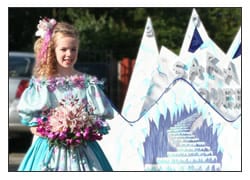 As the personnel of the committees have changed throughout these latter years, so also have the conditions under which they have operated. Health and Safety have seen to that. Since the 90’s both stages in either park have had to be replaced from their original wooden structures to those of modern scaffolding. In the Douglas Park the medieval style split level stage has been replaced by a completely flat stage. Wheel chair access to the Town Hall became a necessity and was provided by Falkirk Council, and its necessary course interfered with the situation of the Coronation Platform. This difficulty was also overcome. The glamorous tableaux floats which housed not only the Queen and her Retinue, but also the Fairies and Flower Girls, had also to be scrapped. Brass and Pipe Bands are no longer as easily obtained as they once were, but again, each year, the procession continues to flourish.
As the personnel of the committees have changed throughout these latter years, so also have the conditions under which they have operated. Health and Safety have seen to that. Since the 90’s both stages in either park have had to be replaced from their original wooden structures to those of modern scaffolding. In the Douglas Park the medieval style split level stage has been replaced by a completely flat stage. Wheel chair access to the Town Hall became a necessity and was provided by Falkirk Council, and its necessary course interfered with the situation of the Coronation Platform. This difficulty was also overcome. The glamorous tableaux floats which housed not only the Queen and her Retinue, but also the Fairies and Flower Girls, had also to be scrapped. Brass and Pipe Bands are no longer as easily obtained as they once were, but again, each year, the procession continues to flourish.
Support for the Fair from everyone is necessary for it to continue, and to improve. It just doesn’t happen without the dedication of the children, the Teachers, Falkirk Council, but probably above all, the hard work of all the members of all the committees which is in operation ALL of each year. Is that hard work worth while? Well, just think what this little town would be like if these magic words weren’t spoken each year – “Ladies and Gentleman, Boys and Girls, we have a new Queen”. It’s an event well worth working hard for, and although our Centenary Fair was celebrated in 1997, our One Hundredth Fair was not celebrated until 2008 because of the gaps created by the two world wars.
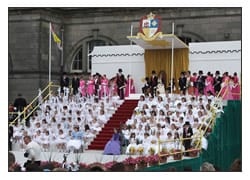 In 2008, as in 1997, every existing Ex-Queen who was able, attended the Fair. Some travelled from all over the world, and were introduced to a massive crowd before the crowning ceremony. They then took their places in the procession in specially acquired limousines, and relived their dream.
In 2008, as in 1997, every existing Ex-Queen who was able, attended the Fair. Some travelled from all over the world, and were introduced to a massive crowd before the crowning ceremony. They then took their places in the procession in specially acquired limousines, and relived their dream.
In this history, only three Queen’s have been named, and although the others are equally deserving of mention, space unfortunately prevents such a listing. Nevertheless, every past Queen, young or old, would surely say they accepted the greatest honour that their home town of Bo’ness could bestow upon them – the day that they were crowned Queen at Bo’ness Children’s Fair Festival – was not only the best day of that year, but one of the very best days of their lives.

